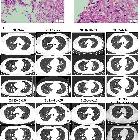Pulmonary fungal disease

The Reversed
Halo Sign in Pulmonary Mucormycosis with cerebral dissemination in immunocompromised host.. +1 day HCT. PA (a) and lateral (b) chest X-ray. Pseudonodular consolidation (white arrow) on the right upper lobe (RUL).

The Reversed
Halo Sign in Pulmonary Mucormycosis with cerebral dissemination in immunocompromised host.. +3 days HCT. PA (a) and lateral (b) chest X-ray. Evolution of the nodular opacity (white arrow) with an increase of density and size.

The Reversed
Halo Sign in Pulmonary Mucormycosis with cerebral dissemination in immunocompromised host.. Axial (a), sagittal (b) and coronal (c) chest CT demonstrate a pulmonary mass with three components: central ground glass opacity (“reversed halo sign”) (*) and peripheral (arrow) ground glass opacity (halo sign) and intermedial consolidation.

Pulmonary
aspergillosis • Angioinvasive aspergillosis - Ganzer Fall bei Radiopaedia

Pulmonary
aspergillosis • Aspergillosis - Ganzer Fall bei Radiopaedia

Aspergilloma
• Monod sign (aspergilloma) - Ganzer Fall bei Radiopaedia

Pulmonary
aspergillosis • Aspergillus bronchopneumonia - Ganzer Fall bei Radiopaedia

Pulmonary
aspergillosis • Invasive pulmonary aspergillosis - Ganzer Fall bei Radiopaedia

Cryptococcosis
with pulmonary cavitation in an immunocompetent child: a case report and literature review. Images. a CT on admission showed a lesion and cavities in the right lower lobe of the lung, suggesting infection. b CT on the recovery phase (after taking fluconazole orally for 1 month) showed the lesion in the lower lobe of the right lung had reduced. c CT on the recovery phase (after taking fluconazole orally for 4 month) showed the inflammation in the lower lobe of the right lung had well absorbed

Establishment
and evaluation of a CT-based radiomic model for AIDS-associated pulmonary cryptococcosis. A 25-year-old male with AIDS complicated by Cryptococcus pneumonia presented to the hospital with fever for 2 weeks. A CT scan showed a thin-walled cavity in the lower lobe of the left lung. The automatic machine delineated the lesion approximately 1–2 mm from its outer edge
Pulmonary fungal disease encompasses a broad spectrum of infections related to fungal sources. They can particularly affect immunocompromised individuals.
These include:
- pulmonary aspergillosis: pulmonary aspergillus infection considered the most important in immunocompromised individuals
- aspergilloma (saprophytic/non-invasive aspergillosis): the most common form seen radiographically
- allergic bronchopulmonary aspergillosis (ABPA)
- invasive aspergillosis
- chronic necrotizing aspergillosis (CNA) (or semi-invasive aspergillosis)
- airway invasive aspergillosis (or bronchopneumonic aspergillosis)
- angioinvasive aspergillosis
- obstructive bronchopulmonary aspergillosis
- pulmonary candidiasis
- pulmonary histoplasmosis
- pulmonary blastomycosis
- pulmonary cryptococcosis
- pulmonary mucormycosis
- pulmonary scedoporium infection
- pulmonary Pneumocystis jirovecii infection (now considered a form of fungus)
Serological markers
(1,3)-β-D-glucan serum concentrations: may have a role in detecting some situations with disseminated infection .
Siehe auch:
und weiter:

 Assoziationen und Differentialdiagnosen zu pulmonale Pilzinfektionen:
Assoziationen und Differentialdiagnosen zu pulmonale Pilzinfektionen:



